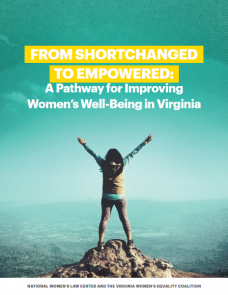Abortion rights, women of color, and LGBTQI+ people are under attack. Pledge to join us in fighting for gender justice.
 In this report – the first in a series of state-based analyses – we provide an overview of Virginia women’s well-being around four core pillars of gender justice: adequate and equitable wages; affordable, high-quality child care; protection from sexual harassment; and access to abortion. We find a decidedly mixed environment facing women, one that requires public policy solutions and the commitment of leaders in Virginia – and nationally – to address.
In this report – the first in a series of state-based analyses – we provide an overview of Virginia women’s well-being around four core pillars of gender justice: adequate and equitable wages; affordable, high-quality child care; protection from sexual harassment; and access to abortion. We find a decidedly mixed environment facing women, one that requires public policy solutions and the commitment of leaders in Virginia – and nationally – to address.
Over the past 20 years, Virginia’s gender wage gap has narrowed by only four cents, with women today being paid only 81 cents to every dollar paid to men. At the same time, child care costs have risen by more than 37 to 39 percent in real dollars over the past decade, outpacing the typical Virginia woman’s wage growth (five percent) by more than seven times. Women also face barriers to living safe and healthy lives. Despite the MeToo movement, the Virginia legislature has failed to pass most of the myriad bills introduced to address sexual harassment and other forms of discrimination, like pay and pregnancy discrimination, that occur alongside and further entrench harassment. And women have limited access to full reproductive health care in Virginia, with 80 percent of Virginia women living in counties without a clinic that performs abortions.
Building a state and a nation that delivers justice for all requires a broad and encompassing vision for gender justice. It requires a commitment – at the national, state, and local levels – to combating unfair and discriminatory policies and to creating the conditions in which women can make real decisions about whether and when to start a family, access affordable, high-quality child care, and pursue work that pays them equitably and treats them with dignity. Below, we delineate the progress Virginia has yet to make – progress that Virginia women are increasingly demanding – as well as the policy solutions that will make this vision a reality.

